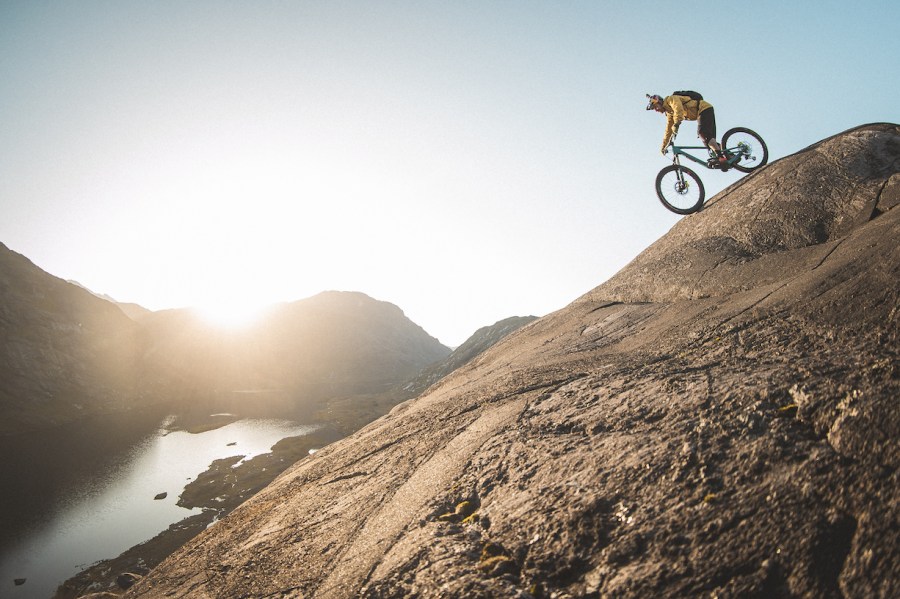Watched that jaw-dropping Danny MacAskill video and want to have a go at this classic scramble the ‘old fashioned’ way, on foot? Hanna Lindon guides us through it.
If you’re one of the 2.1-million people (and counting) who have watched Danny MacAskill rock-hopping down Skye’s Dubh Slabs on his trials bike, you’ll already know all about the appeal of this classic Cuillin climb. You might even have wondered whether you could take it on yourself. Not on two wheels, obviously, because MacAskill is in a class of his own when it comes to venturing where no bike has gone before. But on foot? With the right experience (or a Cuillin-savvy guide) it’s certainly possible.
Main image: Danny MacAskill on his jaw-dropping ride down the Dubh Slabs. Photo: Dave Mackison
What are the Dubhs?
The Dubh Slabs (and the ridge that follows on from them – together usually referred to as the Dubh Ridge or just ‘the Dubhs’) are officially classified as a moderate climbing route – a sort of middle ground between grade 3 scrambling and ‘proper’ rock climbing. They beat a deliciously grippy gabbro path from the shores of Loch Coruisk to Sgurr Dubh Beag’s cylindrical summit (733m), before the Dubh Ridge continues on to link Sgurr Dubh Mor (944m) and Sgurr Dubh na Da Bheinn (938m).
This superlative route is (according to a very unscientific census of hillwalkers and climbers) just about the best line to the top of a mountain that you’ll find anywhere in Britain. So beloved is this route among the mountaineering fraternity, in fact, that ‘doing the Dubhs’ is Skye parlance for ‘having one of the most awesome hill days possible’.
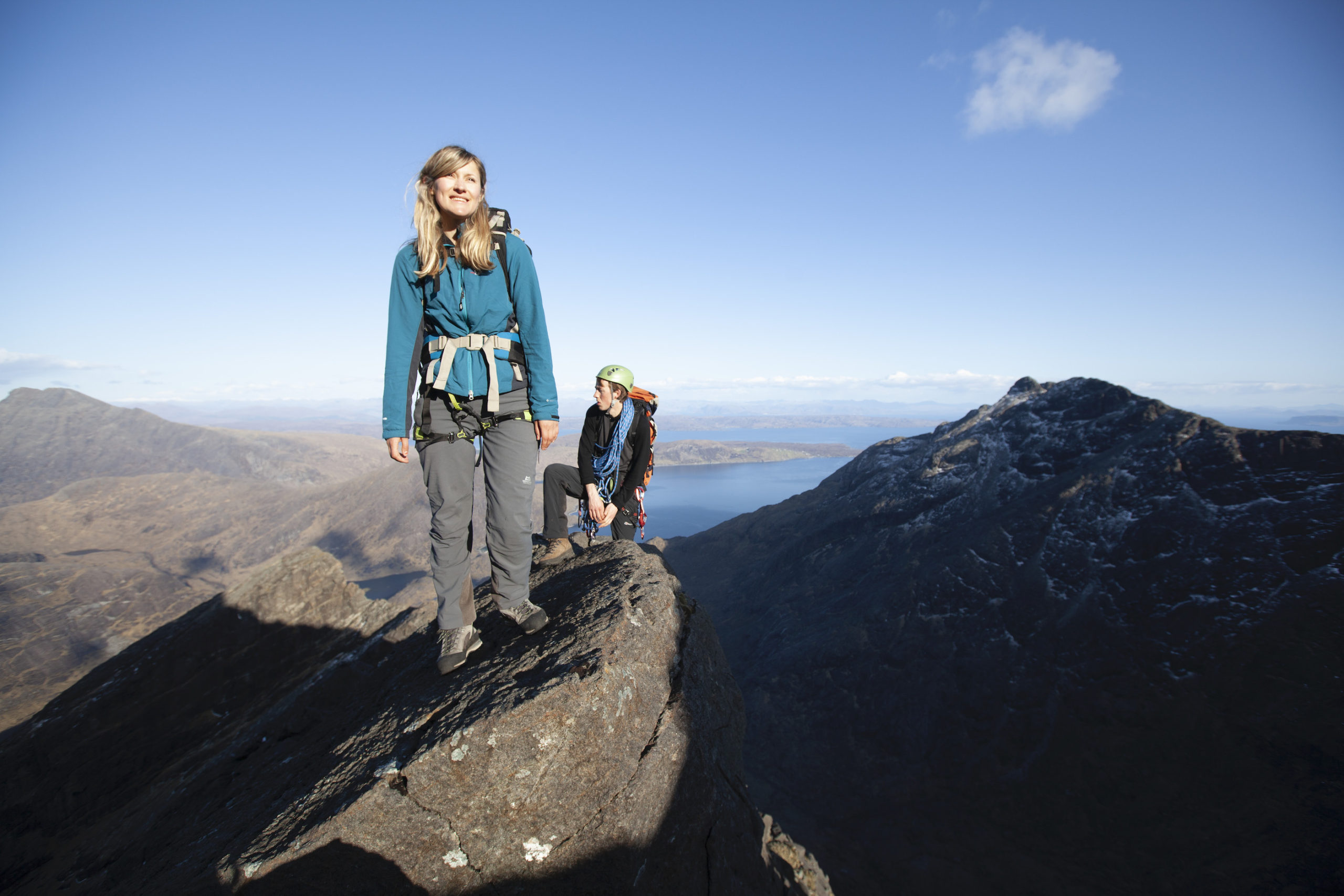
Topping out after doing the Dubhs’. Photo: Hanna Lindon
That’s the good stuff. The bad news is that the Slabs are so hemmed in by crazily-contoured mountain scenery that getting there and back in a day is a big part of the challenge. I’m an authority on this, because I once got stuck near the top at dusk and had to spend the night in an improvised bivvy near the summit of Sgurr Dubh Mor. This isn’t something I confess to seasoned Skye guide Mike when I call him for tips on how to tackle the route safely.
What’s the best approach?
“The Dubhs are massively underestimated,” he says, as I nod in guilty agreement. “They get all the plaudits as absolutely bloody brilliant, but there’s no denying that they are fundamentally very difficult to get to. I always say that Loch Coruisk is like the inner keep of the Cuillin castle, guarded by either massive walls, the sea, or a long walk down Glen Sligachan. It’s an epic day out even before you’ve started the main route.”
One way to overcome these topographical challenges is to use the boat service that operates from Elgol. It’s a scenic start to the day, but it gives you just eight hours to get up to the 944m summit of Sgurr Dubh Mor and back again in time for the last boat.
“It puts an awful lot of time pressure on your day,” says Mike. “My favoured option is to catch the boat in and walk out to Glen Brittle – but then you have the logistics of transport. A more traditional way to do it is to approach from Glen Brittle, going up over Bealach Coire na Banachdich and then descending again to the foot of the Slabs.”
The downside to that? You’ll need the endurance of an ox to manage the 700-metre ascent and subsequent plunge down to sea level, followed by another 700 metres of slabby scrambling, a heart-in-mouth abseil and an even more heart-in-mouth ridge tittup. That’s all before you’ve even begun thinking about the way home.
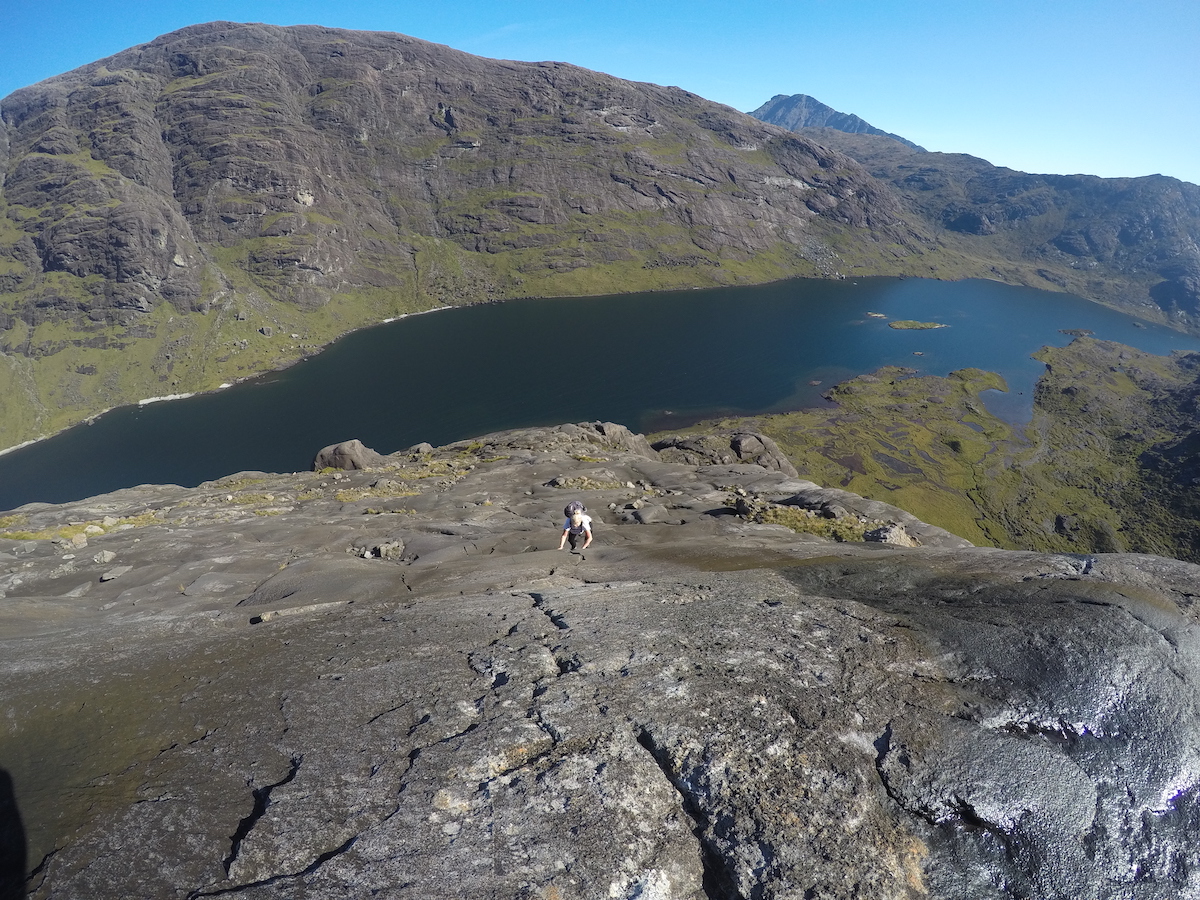
Photo by Jonathan Wood
I tentatively suggest to Mike that an alternative plan might be to wild camp at Coruisk, and he agrees. “You wouldn’t want to do the route with a big backpack, but if you wild camp at the bottom and then walk out again the same way then it isn’t so bad.”
How hard are they really?
“Argh my goodness, that was scary,” puffs Danny McAskill as he bottoms out on Loch Coruisk after a teetery cycle down the Slabs. It’s a sentiment you might find yourself repeating, even if you’re tackling the route with scrambling boots rather than wheels.
“It’s officially a moderate grade, but I’d argue that this is one of the few places in the UK where the British rock climbing system goes out of the window completely,” says Mike. “It’s more suited to an Alpine description.”
One reason for this – other than the approach time – is that you’ll need a rope handy, ready to whip out for protection on some of the gnarlier moves. Then there’s the (avoidable, at a pinch) abseil descent from Sgurr Dubh Beag. And finally the scarily splendid highlight: a final, solidly moderate scramble along the Dubh Ridge to the summit of Sgurr Dubh Mor.
“It’s very much a climb,” says Mike, “and, unless you’ve got a lot of Cuillin experience, you’d be unwise to go there without a rope. Bear in mind that the moderate grade is for the easiest possible line in perfect conditions. You might well not get those perfect conditions… and if you don’t take the easiest line then, in the Cuillin, you’ll quickly get into much harder terrain.”
In other words, you’ll need to be fit, red-hot at mountain navigation and savvy with a rope (or at least accompanied by somebody who is).
What are the major difficulties?
The Dubhs have a few juicy challenges up their sleeves – not least getting onto the Slabs in the first place.
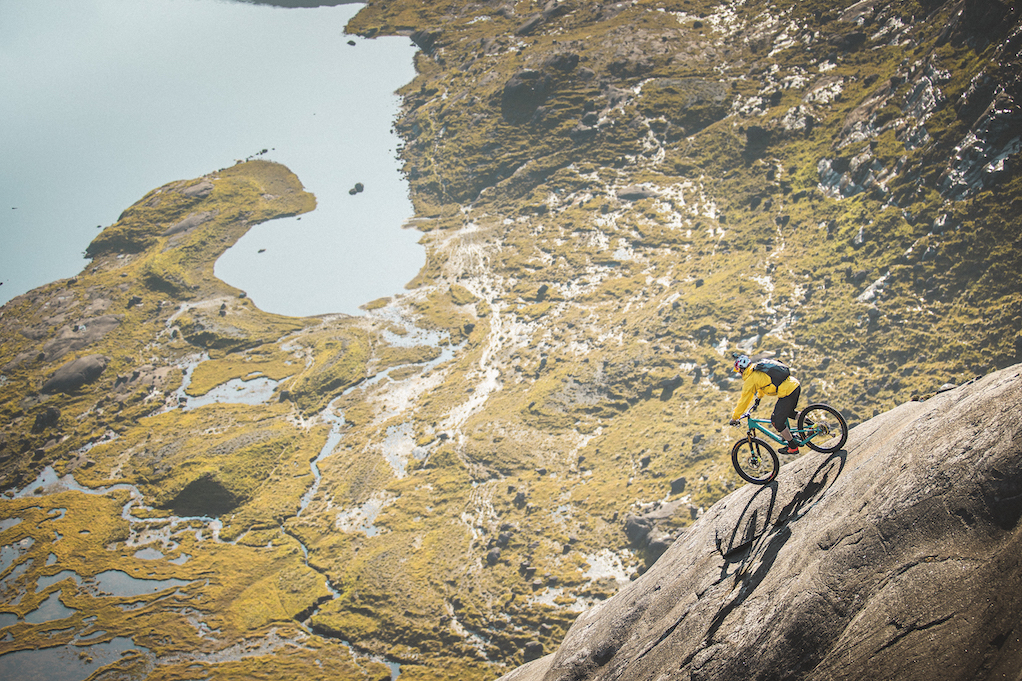
Danny’s head-spinning ride has been watched millions of times on Youtube. Photo: Dave Mackison
“There are really two choices,” Mike explains. “One you can see on the Danny MacAskill video – as he comes down that final ascent, there’s a recessed gully and that’s the normal route for getting up. It has one move on it that’s probably moderate/diff – enough to make you think straight away! As a guide, I’ll generally put a rope on people here.
The alternative is to take the open gully facing you on the approach from the jetty along Loch Coruisk. It’s possible to reach the easier main section of the slabs more quickly by going straight up here – but you’ll still have to tackle a couple of moderate moves along the way.
Take either of those options and you’ll emerge on to the continuous open slabs that everyone raves about. There are many things to get excited about over the next sublime 700 metres – the grippiness of the rock, the views, the sustained nature of the route – but don’t lose your head completely. “It’s possible to choose a good line without much difficulty, the real challenge is not getting over-confident,” Mike warns. “You’ll get tempted by those lovely slabs [to stray off-line], but the difficulty can ramp up very quickly.”
Do I have to do the abseil?
Experienced scramblers should fare fine on the main body of the ascent, but the summit of Sgurr Dubh Beag holds a nervy surprise. The only way to continue on from here is by abseil – and not a straightforward one either. “It’s complex, because you can’t see exactly where you want to get down to and it’s usually adorned by a variety of abseil tat,” explains Mike. “If you take the higher anchor and you use a 50m rope doubled up, you might be wondering whether you’re going to get your rope back.”
If your rope skills don’t quite extend to abseiling over an overhang (or if you’re banking on getting the last boat back and time is of the essence), there’s a rapid bypass that leaves the main route on the east side of the ridge about 10 minutes before the summit.
Is that it?
Nope – the scramble up to Sgurr Dubh Beag (733m) is just half of the fun. After a hand-on-rock descent to the next col, there’s more than two hours of trickier and even more thrilling scrambling along the Dubh Ridge to Sgurr Dubh Mor. If your thigh muscles aren’t protesting too angrily by this point then it’s the highlight of the route – fabulous, airy scrambling with Cuillin wherever you look and the blue backdrop of the sea shimmering away in the distance.
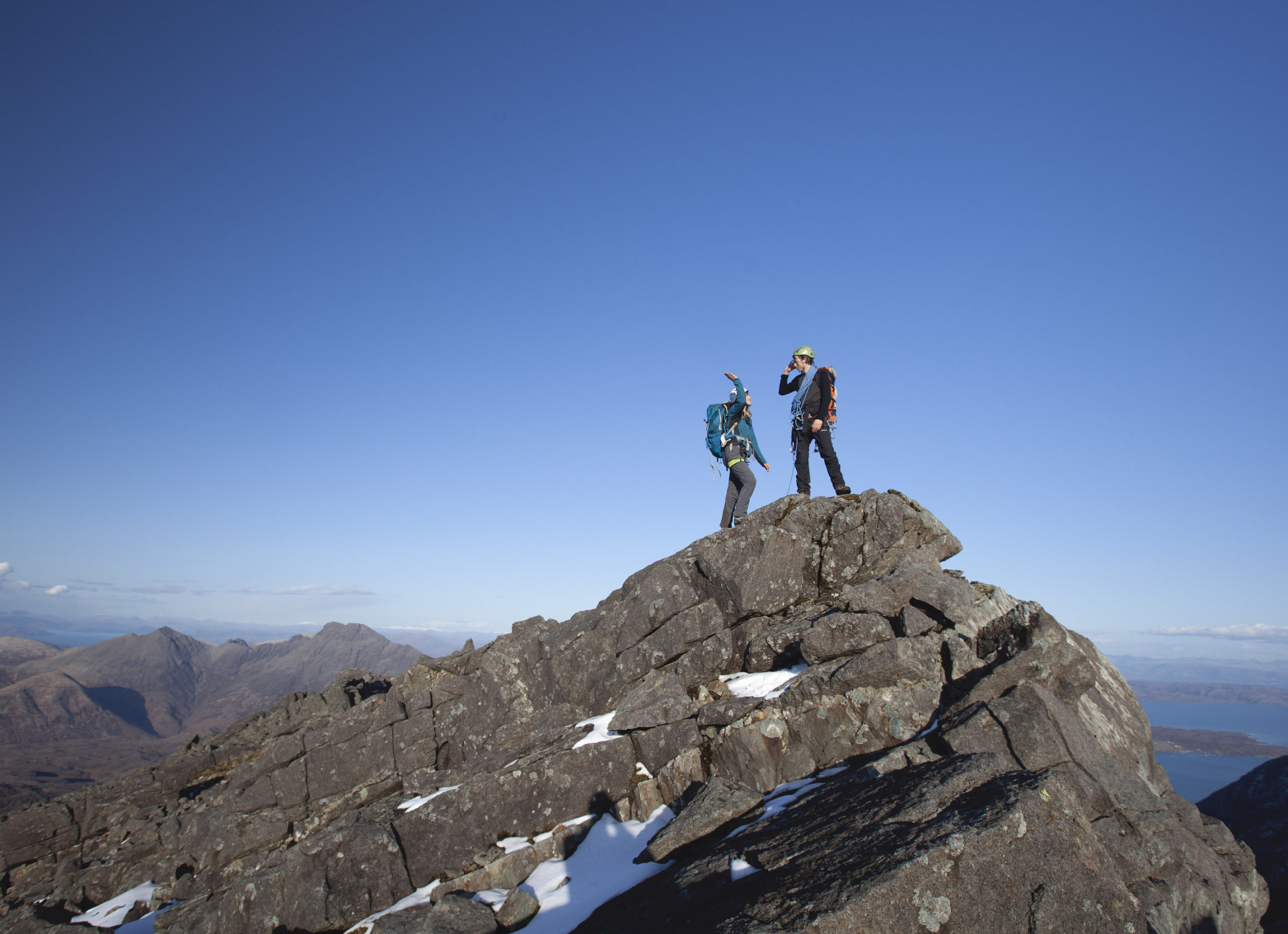
The views from the Dubh Ridge are breathtaking. Photo: Hanna Lindon
“That brings you up to the complex face of Dubh Mor,” says Mike. “If you take it direct then you can come across moves that are 4b or 4c… definitely rock climbing territory. But the easier route to the summit actually hangs on the southern flank and follows a variety of terraces leftwards.”
A little bit of fun mountain geekery here: Sgurr Dubh Mor is a debated summit, with two tops that are identical in height. The summit cairn is on the western top. From here the route continues on for around 100m, weaving down between rock pinnacles before ascending again to 938m Sgurr Dubh an Da Bheinn. And that’s it! The last high point of the day. But it’s a long way back down….
How do I get down?
That depends where you’re trying to get to. “To return to Coruisk, descend via Caisteal a’Garbh-choire and down the An Garbh-choire,” says Mike. “Simpler is to follow Coir’ a Ghrunnda back to the footpath that returns you to Glen Brittle.”
Both are long and gruelling descents and not straightforward to locate, particularly if the light is starting to disappear. One more reason to plan well and proceed with caution – or you might just find yours find yourself spending a long, cold night up on the ridge.
Ah well. It was a Dubh-licious dawn.
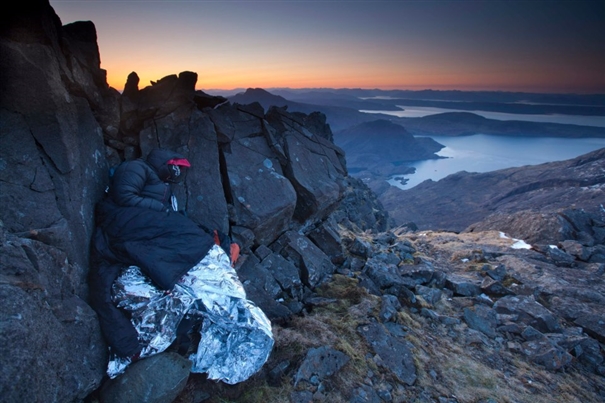
Hanna’s impromptu night on the Dubh Ridge
Mike Lates is the owner and director of Skye Guides and the author of SMC guidebook ‘Skye, The Cuillin’(RRP £25).

